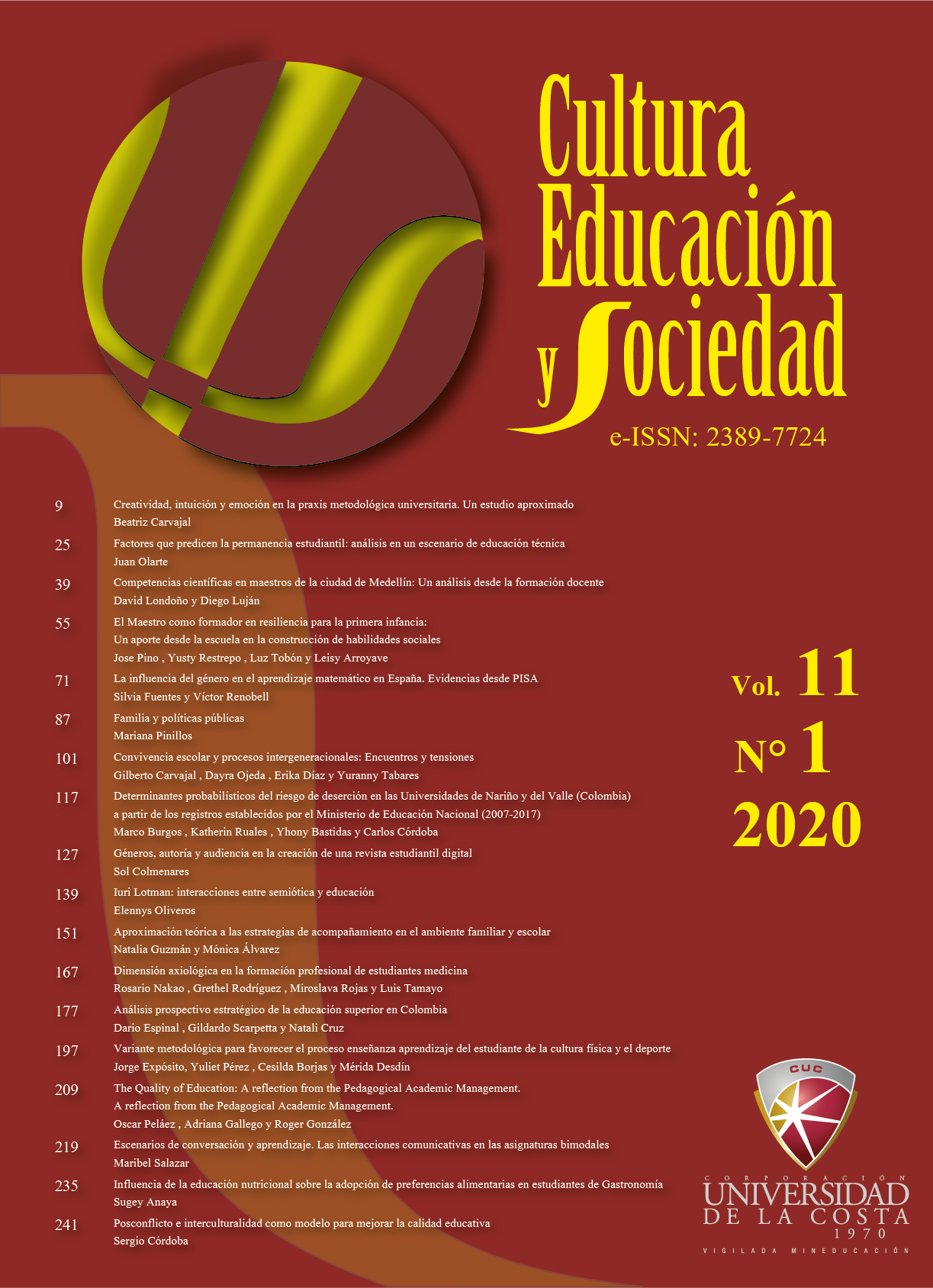Conversation and learning scenarios: Communicative interactions in blended subjects
DOI:
https://doi.org/10.17981/cultedusoc.11.1.2020.16Keywords:
Blended learning, Learning platform, Communicative interactions, Teachers, StudentsAbstract
The article exposes the results of the research From the traditional classroom to the interactions in the virtual environment: blended subject characterization model of the University of Medellín, Colombia. The particularities of the blended subjects and the communicative interactions between teachers and students in the UVirtual educational platform and the influence that graphic design has on this dynamic are analyzed. The object of study is three (3) blended subjects from the Faculty of Communication. As characterization techniques we work with observation, interview and survey. In the process, a common structure is revealed with slight variations according to the teachers’ approach; It is evident that students prefer external communication to the platform, but they use the language of the Internet and graphic design makes it easier for them to apprehend information. As one of the conclusions, the approach to this modality allows the development of new communication skills and information management.
Downloads
References
Etchevers, N. E. (2006). Los nuevos códigos de la comunicación emocional utilizados en Internet. Teoría de la Educación. Educación y Cultura en la Sociedad de la Información, 7(2), 92–106. Disponible en https://gredos.usal.es/handle/10366/56526
Garrison, D. R. y Anderson, T. (2005). El e-learning en el siglo XXI. Investigación y práctica. Barcelona: Octaedro.
Hara, N., Bonk, C. J. & Angeli, C. (2000). Content analysis of online discussion in an applied educational psychology course. Instructional Science, 28(2), 115–152. https://doi.org/10.1023/A:1003764722829
Hernández, R., Fernández, C. y Baptista, P. (2006). Metodología de la Investigación. (4ª ed.). México, D.F.: McGraw-Hill.
Marín, F. V., Inciarte, A. de J., Hernández, H. G. y Pitre, R. C. (2017). Estrategias de las Instituciones de Educación Superior para la Integración de las Tecnología de la Información y la Comunicación y de la Innovación en los Procesos de Enseñanza. Un Estudio en el Distrito de Barranquilla, Colombia. Formación Universitaria, 10(6), 29–38. http://dx.doi.org/10.4067/S0718-50062017000600004
Moral, F. y García, R. (2003). Un nuevo lenguaje en la red. Comunicar, 11(21), 133–136. Disponible en https://www.revistacomunicar.com/ojs/index.php/comunicar/article/view/C21-2003-20
Nielsen, J. (january 3, 2012). Usability 101: Introduction to Usability. [Online]. Recuperado de http://www.nngroup.com/articles/usability-101-introduction-to-usability/
Osuna, S. (2009). La comunicación didáctica en los chats académicos. Tecnología y Comunicación Educativas, 22-23(47-48), 83–91. Recuperado de http://tyce.ilce.edu.mx/tyce/47-48/82-91.pdf
Parra, L. A. (2008). Blended learning la nueva formación en educación superior. AVANCES Investigación en Ingeniería, (9), 95–102. Recuperado en http://www.unilibre.edu.co/revistaavances/avances_9/r9_art9.pdf
Pérez, M. S. (2010). La comunicación y la interacción en contextos virtuales de aprendizaje. Revista Apertura, 1(1), 1–21. Disponible en http://www.udgvirtual.udg.mx/apertura/index.php/apertura/article/view/15/18
Pinto, A. y Díaz, J. (2015). Convivencia Escolar en la era de la hiperconectividad. Cultura, Educación y Sociedad, 6(1), 149–164. Recuperado de http://repositoryinst.uniguajira.edu.co/jspui/bitstream/123456789/51/1/Convivencia%20Escolar%20en%20la%20era%20de%20la%20hiperconectividad.pdf
República de Colombia. MEN. (s.f.). Educación virtual o educación en línea. [Online]. Disponible en https://www.mineducacion.gov.co/1759/w3-article-196492.html?_noredirect=1
Rodríguez, M. (2011). Las TIC en la educación superior en Colombia. Revista Unilatina, (1), 7–23. Recuperado de https://unilatina.edu.co/pdf/revista/Las-TIC-en-la-educacion.pdf
Scolari, C. A. (2008). Hipermediaciones: elementos para una teoría de la comunicación digital interactiva. Barcelona: Gedisa.
Universidad de Medellín. Rectoría Universidad. (24 de febrero de 2010). Educación Virtual. [Resolución 90]. Recuperado de https://repository.udem.edu.co/handle/11407/2078
Valverde, J. (2002). Herramientas de comunicación sincrónica y asincrónica. En, J. Cabrero y J. I. Aguaded, Educar en red. Internet como recurso para la educación, (pp. 57–81). Málaga: Aljibe.
Villegas, G. A. y Zea, C. M. (2003). EAFIT Interactiva: Hacia una experiencia educativa bimodal que combina la presencialidad y la virtualidad. [Online]. Recuperado de http://e-spacio.uned.es/fez/eserv.php?pid=bibliuned:1396&dsID=n02villegas03.pdf
Zapata, D., Marín, A. y Vélez, Y. (2012). Metodología de producción de diseño gráfico para un entorno de enseñanza y aprendizaje en un mundo virtual tridimensional (mv3d). Uni-pluri/versidad, 12(1), 14–24. Disponible en https://revistas.udea.edu.co/index.php/unip/article/view/13258
Published
How to Cite
Issue
Section
License
Copyright (c) 2022 CULTURA EDUCACIÓN Y SOCIEDAD

This work is licensed under a Creative Commons Attribution-NonCommercial-NoDerivatives 4.0 International License.
![]()
Creative Commons 2020 CULTURA EDUCACIÓN Y SOCIEDAD
This article is under international license Creative Commons Reconocimiento-NoComercial-SinObrasDerivadas 4.0.
The published articles are the sole responsibility of their authors and do not necessarily reflect the opinions of the editorial committee.
CULTURA EDUCACIÓN Y SOCIEDAD respects the moral rights of its authors, who assign to the editorial committee the patrimonial rights of the published material. In turn, the authors inform that this work is unpublished and has not been previously published.
All articles are under a:
Licencia Creative Commons Atribución-NoComercial-SinDerivadas 4.0 Internacional.
![]()


 English
English
 Español (España)
Español (España)




_12.53_.27_p_. m_._3.png)





_12.57_.35_p_. m_._3.png)
_12.50_.37_p_. m_._3.png)



